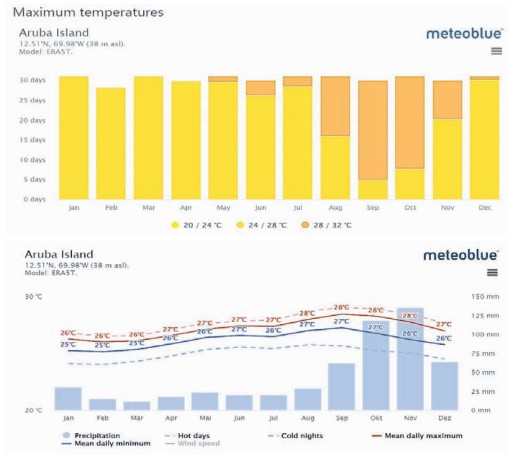In a recent announcement, Meteo Aruba issued a warning to the people of Aruba about excessive heat, as the hottest months of the year are approaching. These months are August, September, and October. High temperatures can have severe effects if necessary precautions are not taken.
A combination of high temperatures and high humidity levels, along with less strong winds than usual, can cause discomfort for certain individuals.
For the maximum temperatures in the coming months, Meteo Aruba reports that they could range from 34°C to 36°C, and humidity levels will be between 85% to 90% or more. This will contribute to a heat index, indicating how hot it feels, around 43°C to 46°C each day.
Meteo Aruba emphasizes that there will not be much change during nighttime hours. The high heat and humidity will not decrease significantly at night, with temperatures only dropping to a minimum of 28°C to 29°C.
This could increase the risk for people who cannot find a place to cool down their bodies. Excessive heat is the number one weather-related killer, and people must be prepared for the dangers that excessive heat can cause. Particularly vulnerable groups include young children, the elderly, and those with heart conditions.
Meteo Aruba recommends limiting outdoor activities to early morning hours or after the sun sets. They also advise using air conditioning if available, or at least opening windows to allow air circulation in the house.
An excessive heat warning means that for a certain period, some months, high temperatures are expected. Meteo emphasizes that the combination of high temperature and high humidity can create a situation where illnesses caused by prolonged exposure to high temperatures may occur.
They advise all to drink plenty of fluids, if possible, stay in air-conditioned rooms or places, avoid sun exposure as much as possible, and wear light-colored and light-weight clothing, preferably white.
It is important for citizens and visitors to know the difference between heat exhaustion and heat stroke. Symptoms of heat exhaustion include headache; dizziness or fainting; heavy sweating; cold, pale, or clammy skin; nausea or vomiting; fast and weak pulse; weakness or muscle cramps; and excessive thirst.
Symptoms of heat stroke, which is a medical emergency, include headache; confusion or delirium; loss of consciousness; no sweating/dry skin; hot, red skin; nausea or vomiting; fast heartbeat; body temperature above 104°F.
In case someone is suffering from heat exhaustion, they should be hydrated with water or sports drinks and avoid alcohol. Move to a cooler place with air conditioning. Lie down. If conscious, drink water slowly. Take a cool bath or apply cold cloths to the body. If vomiting continues, seek medical attention. Remove dark clothing or extra layers of clothing. Act quickly, as heat exhaustion can lead to heat stroke.
If suffering from heat stroke, call 911 immediately as it is a medical emergency. Move the person to a cooler place. Use cold cloths to reduce body temperature. Do not give fluids.
It is also important not to forget about pets, who can also suffer severe effects from the heat. Some essential tips are to provide plenty of fresh, clean water, create a cool environment, avoid hot surfaces, never leave pets in a car, limit outdoor activities, use cooling techniques, and stay alert for signs of trouble, especially symptoms like excessive panting, drooling, fast heartbeat, lack of movement, vomiting, or collapse. If a pet shows these symptoms, seek veterinary attention immediately.
















